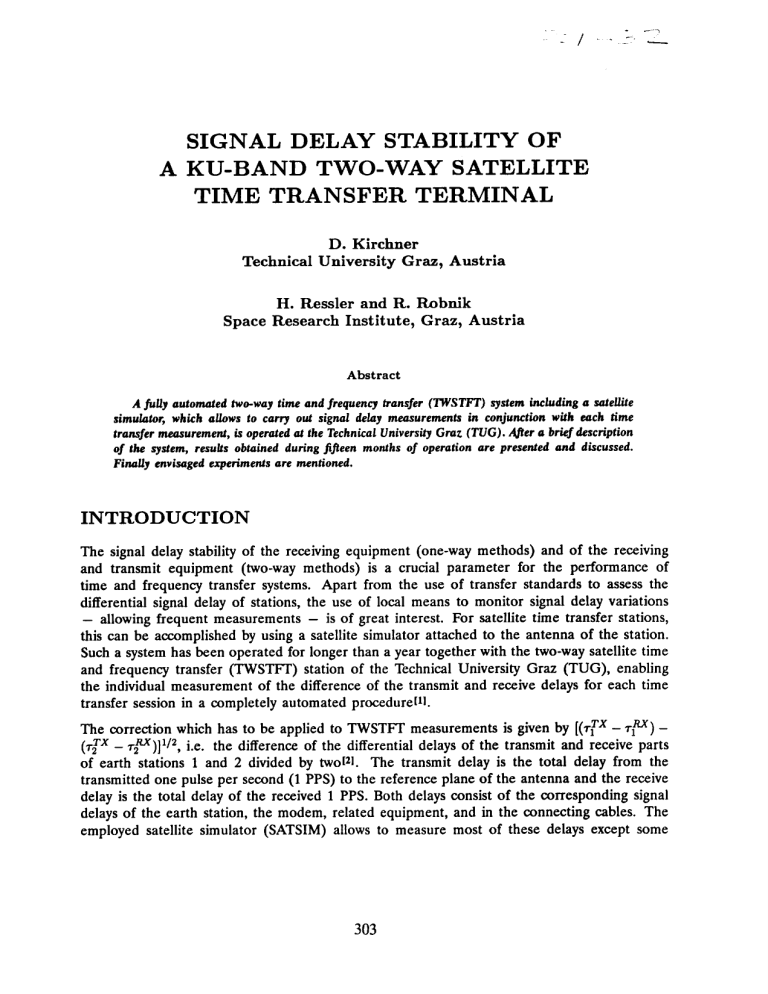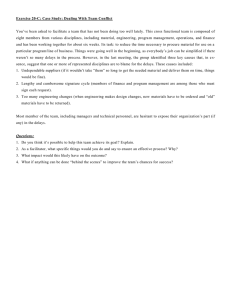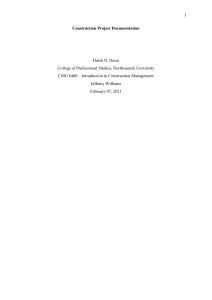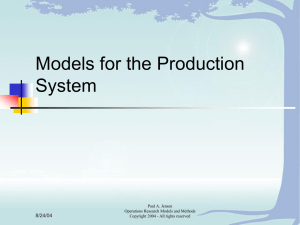
SIGNAL
DELAY
STABILITY
OF
A KU-BAND
TWO-WAY
SATELLITE
TIME
TRANSFER
TERMINAL
D.
Technical
H.
Space
Kirchner
University
Ressler
Research
Graz,
and
R.
Austria
Robnik
Institute,
Graz,
Austria
Abstract
A fully automated two-way time and frequency
transfer (TWSTFT)
system including
simulator, which allows to carry out signal de/ay measurements
in conjunction
with
a s_e///te
each time
transfer measurement,
is operated at the Technical Universfly Graz (TUG). After a brief description
of the system, results obtained during fifteen months of operation are presented
and discussed.
Finally envisaged experiments
are mentioned.
INTRODUCTION
The signal
delay
stability
of the
receiving
equipment
and transmit
equipment
(two-way
methods)
time and frequency
transfer systems.
Apart
(one-way
methods)
and of the
receiving
is a crucial parameter
for the performance
from the use of transfer standards to assess
of
the
differential
signal delay of stations, the use of local means to monitor signal delay variations
- allowing frequent measurements
- is of great interest.
For satellite time transfer stations,
this can be accomplished
by using a satellite simulator attached to the antenna of the station.
Such a system
and frequency
the individual
transfer
session
The correction
has been operated for longer than a year together with the two-way satellite time
transfer (TWSTFr)
station of the Technical University
Graz (TUG),
enabling
measurement
of the difference
of the transmit
and receive delays for each time
in a completely
automated
which has to be applied
(r_ x -- r2S'X)]1/2, i.e.
the difference
proceduretli.
to TWSTFT
of the
differential
measurements
is given
by [(r_ x - T1R-x) --
delays of the transmit
and receive
of earth stations 1 and 2 divided by two[ 21. The transmit delay is the total
transmitted one pulse per second (1 PPS) to the reference
plane of the antenna
parts
delay from the
and the receive
delay is the total delay of the received 1 PPS. Both delays
delays of the earth station, the modem, related
equipment,
consist of the corresponding
signal
and in the connecting
cables.
The
employed
most
satellite
simulator
(SATSIM)
allows
303
to measure
of these
delays
except
some
remaining
delays which have
means of the spread-spectrum
to be evaluated
separately.
The signal delays are measured
by
modem used for the time and frequency transfer measurements.
The separate
transmit
and receive delays of a single modem
can be measured
an oscilloscope,
but only with low accuracy.
With two modems
the corresponding
delays
can be established
by means of
differential
with high accuracy.
MEASUREMENT
SETUP
A detailed description
of the TWSTFT
system used at TUG is given in [1]. The SATSIM
used is of the de Jong typel3, 41 _ this means one can measure
the sum of the earth station
transmit
and receive delays as well as the receive delay only, thus allowing one to calculate
the
difference
of the transmit
and receive delay - but shows some modifications.
The receive and
transmit
antennas are not simply waveguide-to-coax
transitions,
but are horn antennas and, in
the receive
part,
there
is a power
splitter,
making
possible
to measure
power
and frequency
of
the signal transmitted
by the earth station.
In the transmit part, a combination
of attenuators
is used to obtain the same signal power as received
from the satellite.
For shielding
purposes
all components
are in a small metallic
box with the horn antennas
protruding
from the box.
The box is mounted
on the feed boom of the parabolic antenna with the horns facing the
feed.
The side of the box with the horns is covered with microwave
absorbing
material and
protection
from rain is achieved
by a small dome.
The station is fully automated,
providing
remote control
of transmit power, of transmit and receive frequencies,
and of a spectrum
analyzer for various measurement
and monitoring
purposes.
Apart from the actual time
transfer
measurements,
a time-transfer
session consists of several accompanying
measurements:
collection
of
meteorological
data,
a counter
power density ratio (C/No)
measurements
local and remote station, and the different
the
signal
A block
delays
diagram
check,
the
modem
cal_ration,
carrier-to-noise
of the satellite beacon and of the carriers of the
loop measurements
necessary for the calculation
of
of the station.
of the
station
from
the point
of view of the
signal
delays
involved
poss_le
loop arrangements
to measure
the signal delays of interest is shown in Figure
different loops and the corresponding
counter readings (REF - PPSRX + b2) are called:
for modem loop, ID for indoor loop (all indoor equipment
is in a fully air-conditioned
OD for outdoor loop,
and SR for SATSIM
delays
other
delays
STR for SATSIM
loop to measure
are measured
which
loop to measure
the station
the station receive delay.
can only partly
and the
1. The
MOD
room),
transmit and receive delay,
Together with the wanted
be eliminated
by combining
different
measurements.
These remaining
delays have to be evaluated
separately.
CAL is the modem
calibration
(REF - PPSTX + bl) by which TWSTFT
measurements
have to be corrected
to
take into account the delay between the time reference REF and the transmitted
1 PPS PPSTX.
Each
delay
indicated
in a square
gives
the signal
delay
between
the
points
marked
by dots,
e.g. ul is the signal delay from the modem output to the indoor switch input and so on. In
order to distinguish
between
the transmit and receive delays mentioned
above and indicated
by _r, the measured
delays are indicated by t. The transmit
delay t Tx (modem
transmit output
to satellite
simulator
input
not including
the cable
connecting
indoor
and outdoor
equipment)
given by (ul + il + ol + u3 + u4) is obtained by calculating
(STR - SR) and applying the
correction
[cl + c2 + (s2 - sl) + (cc - uc)]. The receive delay t Rx (satellite
simulator output
304
to modem
receive
given by (d4
input
not
including
+ d3 + o2 + i2 + dl)
applying the correction
differential
delay (t Tx-
the
cable
connecting
is obtained
outdoor
by calculating
[-(el + c2) - s2 - (cc - uc) - (ml
tRx)/2
is obtained by calculating
and indoor
(SR - MOD
equipment)
- OD
+ ID)
and
+ m2 - m3) - (i3 - o3 - il - i2)]. The
(STR - 2*SR + MOD + OD - ID)/2
and applying the correction
[(cl + c2) + (s2 - sl/2) + (cc - uc) + (ml + m2 - m3)/2 + (i3
- o3 - il - i2)/2]. Apart from (el + c2) all other terms can either be assumed to be zero or
smaller than 1 ns. The delay cl is 14.55 ns and c2 is about 20 ns. The cables connecting
the
indoor and outdoor equipment
(delays:
cc, uc, dc) are parts of equal lengths (approx.
30 m)
of one cable and in the same duct. Therefore,
signal delay variations are assumed to be equal
for all of them.
The sum of uc and dc and related delays (OD - ID) is measured
for each
session and the three individual delays (cc, uc, de) are measured
occasionally
like other delays
which
in the
respective
present
setup
cannot
be measured
delays t are given without
MEASUREMENTS
TWSTFT
the above
AND
measurements
are carried
in an automated
mentioned
mode.
corrections
In the following
and are designated
the
by 1".
RESULTS
out between
two laboratories
in the USA and six laboratories
in Europe is, 61. Since summer
1994 in connection
with each session all loop measurements
necessary to calculate
the differential
delay are performed.
Each single loop measurement
is
the mean of 100 measurements
with one measurement
per second.
The completion
of all loop
measurements
takes about fifteen minutes, but could be shortened
to about 10 minutes.
The
measurement
the
single
In the
error estimated
measurements
following,
differential
delay
by an error budget
is smaller
measurements
into account
the errors contributed
by
than 50 ps.
accompanying
(T Tx -TRx)/2
taking
-- computed
the
European
from
sessions
are
the delays as measured
presented.
-
The
and the outside
temperature
are given in Figures 2 and 3. There is an obvious correlation
between the differential
signal delay of the station and the outside temperature.
Figure 4 shows the differential
delay
computed
from the transmit and receive delays corrected
for their modeled
temperature
and
humidity behavior.
For the modeling
of the temperature
and humidity
dependence
of the
transmit and receive delays, polynomial
fits were used. During the reported period of about
fifteen months
a total variation of the temperature
of about 35°C and a total variation of the
uncorrected
differential
delay
of about
1.5 ns can be observed.
The uncorrected
trend with a superimposed
seasonal variation of about 600 ps. This
data with the modeled
temperature
and humidity dependence
removed
a kind of aging
effect
DISCUSSION
The stability_!
resulting
OF
in a delay increase
of about
data show
a
trend still exits for the
and seems to represent
400 ps.
RESULTS
of the differential
delay
(T ax - T gx)
as measured
and
of the
corrected
one,
together
with stabilities typically obtained for TWSTFT
measurements
for averaging times up
to 100 s and with stabilities
of crucial system elements, is given in Figure 5. This is a composite
time
and frequency
capability
of a system
stability
plot;
thus,
can be estimatedlll.
from
only one
Stabilities
305
graph the
were
time
calculated
and frequency
from
long-term
transfer
sessions
performing
one measurement
per second or from measurements
carried
out three times per
week (Monday,
Wednesday,
Friday) during the regular
TWSTFT
sessions also performing
one
measurement
per second.
The results
obtained
from the latter
ones were interpolated
to
one-day intervals
to obtain equally spaced data for the stability calculation,
but no corrections
to the obtained
stabilities
were appliedESl.
The measurements
of the differential
delay show
flicker noise PM with a level around 100 ps. This is in agreement
with results
obtained
for
TWSTFr
common-clock
experimentst_l.
For averaging times up to some minutes
TWSTFT
usually
shows white-noise
PM behavior
as indicated
in Figure
5, with the noise
level
depending
on the actual C/N0 of the signal supplied
to the modem.
The ultimate
limit in the currently
used TWSTFT
measurement
scheme is given by the stability of the electronic
counter
used for
the time interval measurements.
A more critical limit seems to result from phase variations
between
reference
the reference
frequency
used
to which the measurements
by the modem
are referred.
for the signal generation
and the time
These phase variations
are reflected
in
CAL, the modem
calibration
(REF - PPSTX
+ bl).
Stabilities
of CAL for the initially used
frequency
distribution
system and an upgraded
system are also given in Figure 5. Because
CAL
is not measured
every second during a TWSTFT
session, but a mean value of 100 measurements
performed
before or after a session is used, the short-term
stability of CAL is crucial for the
short-term
stability of TWSTFT
measurements.
CONCLUSION
Performing
correcting
AND
TWSTFT
the
ENVISAGED
measurements
TWSTFT
data of each
between
station
ACTIVITIES
stations
by the
both
equipped
measured
signal
with
delay
a SATSIM
variations
and
could
considerable
improve
the TWSTFT
stability.
In a measurement
setup designed
for fully
automated
measurements,
a SATSIM can easily be included and operated.
Because during the
SATSIM operation
the earth station is transmitting,
about five minutes of extra satellite time is
needed.
The data obtained can immediately
be used to correct the TWSTFT data for possible
variations of the differential
signal delay of the station.
At the TUG a second earth station
will soon be available, allowing common
clock experiments
with a SATSIM and, thus, the obtaining of some more
between
two stations both
information
on the stability
equipped
limits of
TWSTFT
systems.
Furthermore,
the second station will be used for detailed
investigations
concerning
temperature
and humidity dependence
of the signal delays in order to optimize
the
station design.
ACKNOWLED
GEMENTS
The contribution
of INTELSAT
providing
help of W. Schladowsky
and H. Peintinger
free of charge satellite
transponder
time and the
(OPTV)
in administrative
and technical
matters is
gratefully
acknowledged.
and later
supported
Bank.
on by Prof.
Hartl, University
of Stuttgart,
is deeply appreciated.
The work was
by the Austrian Academy of Sciences and the Jubilee Fund of the Austrian National
The loan of a MITREX
306
modem
initially by the U.S. Naval Observatory
REFERENCES
[1] D. Kirchner,
H. Ressler, and
system for a two-way
satellite
Frequency
and
Time
Forum
R. Robnik 1995, "An automated
signal delay monitoring
time transfer
terminal,"
Proceedings
of the 9th Europea/a
(EFTF),
March
1995, Besanqon,
France,
pp.
75-79.
J
[2] D. Kirchner
Proe.
IEEE,
1991,
"Two-way
79, 983-990.
[3] G. de Jong 1990, "Accurate
time transfer",
Proceedings
1989, pp.
(PTTI)
198-203;
pp.
and
time
transfer
Planning
of the
21st Annual
communication
Meeting,
28-30
Precise
stations
for
Time Forum
Time
November
satellites",
and
1989,
two-way
(EFTF),
Time
Interval
Redondo
Beach,
107-116.
[4] G. de Jong 1995, "Automated
delay measurement
way satellite
time and frequency
transfer",
Proc.
Interval
(PTTI) Applications
and Planning
Meeting,
pp.
via
delay calibration
of satellite
ground
of the 3rd European
Frequency
and
also Proceedings
Applications
California,
satellite
system
for an earth station for two26th Annual
Precise Time and Time
6-8 December
1994, Reston, Virginia,
305-318.
[5] J.A. DeYoung,
WJ. Klepezynski,
A.D. McKinley,
J.A. Davis, P.R. Pearce, E Baumont,
P.C. Claudon,
W. Powell,
P. Grudler,
P. Mai, P. Hetzel, A. Bauch,
G. de Jong, D. Kirchner,
H.
Ressler, A. Soering, C. Hackman,
and L. Veenstra
1995, "The 1994
lantic two-way
satellite
time and frequency
transfer
experiment:
Proceedings
of the 26th Annual Precise Time and Time Interval
Planning
Meeting,
6-8 December,
Reston,
Virginia,
pp. 39-49.
international
Preliminary
(PTrI)
transatresults",
Applications
and
[6] J.A. Davis, P.R. Pearce,
D. Kirchner,
H. Ressler,
P. Hetzel,
A. Soering,
G. de Jong, P.
Grudler,
F. Baumont,
and L. Veenstra
1994, "Two-Way
satellite
time transfer
experiments
between
six European
laboratories
using the INTELSAT
(VA-F13)
satellite,"
Proceedings
Vol.I,
of the
pp.
8th European
Frequency
and
Time
Forum
(EFTF),
1994,
[7] D.W. Allan,
7th European
[8] C. Hackman,
be published
and
A. Lepek
Frequency
and
1993, "Trends
and Time Forum
T.E. Parker,
"Noise
in international
(EFTF),
1993,
analysis
of unevenly
timing,"
Switzerland,
spaced
Proceedings
of the
pp. 221-227.
time
Symposium,
series
data,"
to
in Metrologla.
[9] C. Hackman,
transfer
Germany,
296-314.
S.R. Jefferts, and T.E. Parker 1995, "Common-clock
two-way
satellite
time
experiments,"
Proceedings
of the 1995 IEEE
International
Frequency
Control
31 May-2
June
1995, San Francisco,
307
California,
pp.
275-281.
I,
fT "70MHz
DOWN
CONVERTER
CONVERTER
OUTDOOR
SWITCH
OUTDOOR
INDOOR
INDOOR
SWITCH
70 / 70 MHZ
i MODEM
PPSTX
i
PPSRX
REF
Figure
1
measurement
Station
loops.
diagram
showing
308
the
different
signal
delays
and
1995
A
-24
S
I
O
I
N
I
O
I
J
I
F
I
DIFFERENTIAL
(STRc_
M
I
A
I
OELAY
2*SIq
+ MO0
M
I
J
1
J
I
A
I
S
I
0
I
N
(TTX-TRX)/2:
+OE)-ID)/2
-25
><
.3
LIJ
O
.J
<
IZ
w
nr
w
u.
u_
a
-26
-27
-28
....
I .........
600
I .........
700
I .........
800
MJD
Fiqure
2
Differential
TRXas
measured.
delay
-
I .........
900
i ' '
1000
(T Tx
49000
-
TRX)/2
computed
from
1995
A
4O
S
I
0
I
N
I
0
1
J
I
F
I
M
I
A
I
M
I
J
I
J
I
A
I
S
I
0
I
N
30
O
0
w
n,
D
2O
<
w
10
w
-I0
....
i .........
600
I .........
700
i .........
800
MJO
Figure
3
Outside
temperature.
309
-
49000
i .........
g00
i ' •
1000
T Tx
and
1995
-24
A
S
0
N
O
J
F
M
A
M
J
J
A
S
O
I
I
I
I
I
I
I
I
I
t
I
I
I
I
I
DIFFE#ENTIAL
DELAY
COI_#ECTEE)
-25
FO#
HUMIDITY
N
(TTX-TI_X)/2:
MOOELLED
DEPENOENCE
TEMPEI_ATUIqE
OF
T
TM
AND
AND
T Iqx
)-
,,-I,
O
_
-26
'
I-Z
w
w
-27.
0
-28
....
,
i .........
700
600
i .........
800
MJD
-
-7.
Mod.
-
TRX)/2
and
computed
humidity
from
T TX
dependence
and
of
_y(_-)
-8
-9
-10
-11
/
/
/
/
/
;
' ,
1000
49000
F_ure
4
Differential
delay
(T TX
T
corrected
for
modelled
temperature
T Tx
and
T Rx
log
i
900
12
/
-13
-14
/
/
-15
_.,/,/,/,/,///,/
-16
-lo.
"
O/_
÷_*
/
/
_@_
-18
,
_
O_
"/
-12
/
+0
"£7////
////_//h.//
+I
/
+2
+3
+4
log
Figure
measured
5
Stabilities
(1)
and
'I_STFT
measurements
TWSTFT
measurements
initially
bution
used
of
('i_),
(a),
(b)
and
an
/
+5
+6
and
delays
for
temperature
of
an
electronic
the
modem
of
upgraded
system.
310
+7
+8
[-r/s)
differential
corrected
0
/
2
b
(c)
(T Tx
and
-
TRX)/2
humidity
counter
calibration
frequency
and
as
(2),
used
CAL
time
for
of
for
the
distri-
Questions
DR.
GERNOT
WINKLER
on temperature
correlators.
DIETER
DR.
GERNOT
content,
content,
DIETER
ment,
and
because
with
Winkler.
Maybe I have
measurement.
you
to consider
have
to add an error
is the
physical
humidity
It's better
which
absolute
give you
a better
operation,
is an error
smaller
311/312
depending
temperature
are strong
Yes, I know.
to use temperature
is independent
humidity,
or grams
and abso-
of temperature
per
cubic
meter
result.
UNIVERSITY
for the real
a correction,
and
GRAZ)"
parameter
So using
should
budget
that
RETIRED):
(TECHNICAL
But again,
If you provide
UNIVERSITY
temperature.
temperature
KIRCHNER
Dr.
RETIRED):
(USNO,
that
Answers
(USNO,
(TECHNICAL
WlNKLER
less correlated
water
humidity,
KIRCHNER
lute water
-
and
and
GRAZ):
we will simply
than
Thank
use the
50 picoseconds
you for this commeasured
figures.
for one calibration




